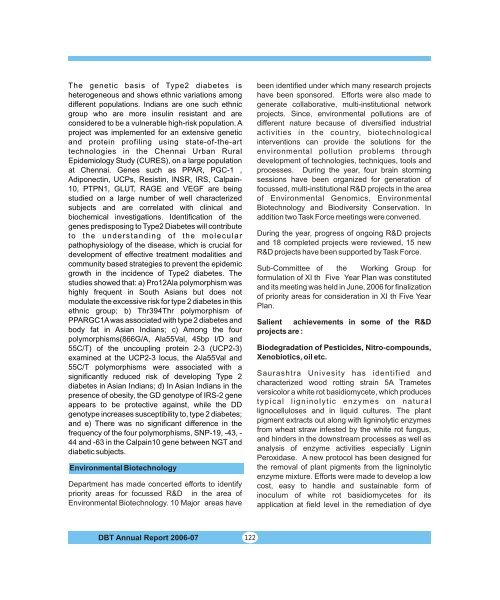ANNUAL REPORT - Department of Biotechnology
ANNUAL REPORT - Department of Biotechnology
ANNUAL REPORT - Department of Biotechnology
Create successful ePaper yourself
Turn your PDF publications into a flip-book with our unique Google optimized e-Paper software.
The genetic basis <strong>of</strong> Type2 diabetes is<br />
heterogeneous and shows ethnic variations among<br />
different populations. Indians are one such ethnic<br />
group who are more insulin resistant and are<br />
considered to be a vulnerable high-risk population. A<br />
project was implemented for an extensive genetic<br />
and protein pr<strong>of</strong>iling using state-<strong>of</strong>-the-art<br />
technologies in the Chennai Urban Rural<br />
Epidemiology Study (CURES), on a large population<br />
at Chennai. Genes such as PPAR, PGC-1 ,<br />
Adiponectin, UCPs, Resistin, INSR, IRS, Calpain-<br />
10, PTPN1, GLUT, RAGE and VEGF are being<br />
studied on a large number <strong>of</strong> well characterized<br />
subjects and are correlated with clinical and<br />
biochemical investigations. Identification <strong>of</strong> the<br />
genes predisposing to Type2 Diabetes will contribute<br />
to the understanding <strong>of</strong> the molecular<br />
pathophysiology <strong>of</strong> the disease, which is crucial for<br />
development <strong>of</strong> effective treatment modalities and<br />
community based strategies to prevent the epidemic<br />
growth in the incidence <strong>of</strong> Type2 diabetes. The<br />
studies showed that: a) Pro12Ala polymorphism was<br />
highly frequent in South Asians but does not<br />
modulate the excessive risk for type 2 diabetes in this<br />
ethnic group; b) Thr394Thr polymorphism <strong>of</strong><br />
PPARGC1A was associated with type 2 diabetes and<br />
body fat in Asian Indians; c) Among the four<br />
polymorphisms(866G/A, Ala55Val, 45bp I/D and<br />
55C/T) <strong>of</strong> the uncoupling protein 2-3 (UCP2-3)<br />
examined at the UCP2-3 locus, the Ala55Val and<br />
55C/T polymorphisms were associated with a<br />
significantly reduced risk <strong>of</strong> developing Type 2<br />
diabetes in Asian Indians; d) In Asian Indians in the<br />
presence <strong>of</strong> obesity, the GD genotype <strong>of</strong> IRS-2 gene<br />
appears to be protective against, while the DD<br />
genotype increases susceptibility to, type 2 diabetes;<br />
and e) There was no significant difference in the<br />
frequency <strong>of</strong> the four polymorphisms, SNP-19, -43, -<br />
44 and -63 in the Calpain10 gene between NGT and<br />
diabetic subjects.<br />
Environmental <strong>Biotechnology</strong><br />
<strong>Department</strong> has made concerted efforts to identify<br />
priority areas for focussed R&D in the area <strong>of</strong><br />
Environmental <strong>Biotechnology</strong>. 10 Major areas have<br />
DBT Annual Report 2006-07<br />
122<br />
been identified under which many research projects<br />
have been sponsored. Efforts were also made to<br />
generate collaborative, multi-institutional network<br />
projects. Since, environmental pollutions are <strong>of</strong><br />
different nature because <strong>of</strong> diversified industrial<br />
activities in the country, biotechnological<br />
interventions can provide the solutions for the<br />
environmental pollution problems through<br />
development <strong>of</strong> technologies, techniques, tools and<br />
processes. During the year, four brain storming<br />
sessions have been organized for generation <strong>of</strong><br />
focussed, multi-institutional R&D projects in the area<br />
<strong>of</strong> Environmental Genomics, Environmental<br />
<strong>Biotechnology</strong> and Biodiversity Conservation. In<br />
addition two Task Force meetings were convened.<br />
During the year, progress <strong>of</strong> ongoing R&D projects<br />
and 18 completed projects were reviewed, 15 new<br />
R&D projects have been supported by Task Force.<br />
Sub-Committee <strong>of</strong> the Working Group for<br />
formulation <strong>of</strong> XI th Five Year Plan was constituted<br />
and its meeting was held in June, 2006 for finalization<br />
<strong>of</strong> priority areas for consideration in XI th Five Year<br />
Plan.<br />
Salient achievements in some <strong>of</strong> the R&D<br />
projects are :<br />
Biodegradation <strong>of</strong> Pesticides, Nitro-compounds,<br />
Xenobiotics, oil etc.<br />
Saurashtra Univesity has identified and<br />
characterized wood rotting strain 5A Trametes<br />
versicolor a white rot basidiomycete, which produces<br />
typical ligninolytic enzymes on natural<br />
lignocelluloses and in liquid cultures. The plant<br />
pigment extracts out along with ligninolytic enzymes<br />
from wheat straw infested by the white rot fungus,<br />
and hinders in the downstream processes as well as<br />
analysis <strong>of</strong> enzyme activities especially Lignin<br />
Peroxidase. A new protocol has been designed for<br />
the removal <strong>of</strong> plant pigments from the ligninolytic<br />
enzyme mixture. Efforts were made to develop a low<br />
cost, easy to handle and sustainable form <strong>of</strong><br />
inoculum <strong>of</strong> white rot basidiomycetes for its<br />
application at field level in the remediation <strong>of</strong> dye

















